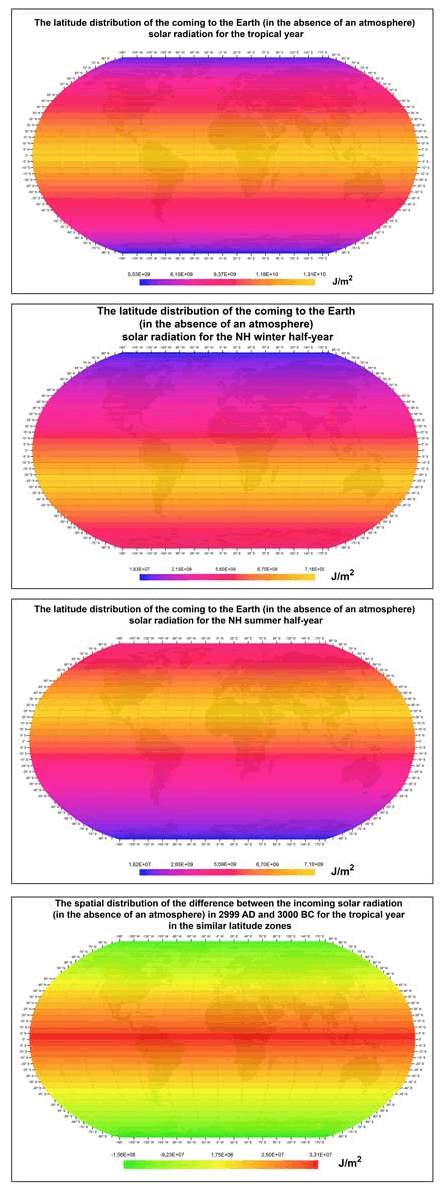| |
SOLAR RADIATION AND CLIMATE
OF THE EARTH |
|
"The main reason for all heat phenomena on the surface of the Earth and in the atmosphere is solar radiation, its spatial distribution conditioned by the shape of the surface of the Earth, and time changes related to rotation of the Earth around the Sun and its own axis"
Comprehensive information concerning the changes of the natural environment happening these days and related to global climate changes determine an extremely important role of global climate studies. Suggestions pertaining to an important connection between these changes and the greenhouse effect and human influence (due to CO2 emissions into the atmosphere from burning fossil fuels, thermal pollution, increase of aerosol concentrations in the atmosphere) bring our attention to climate changes and account for making environmental, social, economic (for example, related to determination of agro-climatic and water resources, agricultural production, supplies provision) and political decisions (for example, related to the Vienna Convention for the Protection of the Ozone Layer, the Montreal Protocol, the Climate Framework Convention, the Kyoto Protocol, the RF Climate Doctrine, etc.). (Robinson, 1981; Kiling, Bakastow, 1981;; http://kremlin.ru/acts/6365; http://www.wmo.int/pages/index_ru.html; http://www.climate.gov/). However, despite the recently available climatological information and evident importance of the issue, it is yet impossible to perceive the essence of processes that shape and change the climate, which reflects a high level of complexity of this physical problem. All existing approaches to this issue include monitoring and collection of climatological information, reviewing (such as reports of the Intergovernmental Panel on Climate Change, IPCC) and modeling various scenarios of climate development with respect to arbitrary changes of its parameters and characteristics (Climate changes, 1981; Smagorinskiy, 1981; Kondratyev, 1987; Man-induced climate changes, 1987; Upcoming changes.., 1991; Semenov, et al. 2008; Gruza, Rankova, 2012; http://www.wmo.int/pages/index_ru.html; http://www.ipcc.ch). The most important challenge in studying and forecasting climate changes, which is finding an answer to the question of what the reasons for these changes are, remains unsolved. At the same time, there is no doubt that solar radiation supplying light and heat to the Earth is of the greatest importance in the climate genesis and life development on the planet. Solar radiation is the main energy source that determines the radiation and thermal balance of the Earth, its surface, atmosphere and the World Ocean, along with the thermal conditions of the biosphere (Zubov, 1938; Alisov et al., 1952; Shuleykin, 1953; Kondratyev, 1965; Dzerdzeyevskiy, 1967; Khromov, 1968; Lorentz, 1970; Budyko, 1974; 1980; Garvey, 1982; Monin, 1982; Hrgian, 1986; Gill, 1986; Voytkevich, Vronskiy, 1989; Monin, Shishkov, 1979, 2000). Solar climate is theoretically measured amount of incoming and distributed solar radiation in the outer atmosphere or on the surface of the Earth in the absence of the atmosphere (Milankovich, 1939; Alisov, Poltaraus, 1974; Monin, Shishkov, 1979; Drozdov et al., 1989; Khromov, Petrosyanz, 2006). Variations of solar radiation coming to the Earth are defined by two major reasons of different physical nature. Studies of the solar radiation variations related to physical activity of the Sun were initiated long time ago. The issue concerning the connection between solar activity changes and climate changes has also been discussed for a long time and still remains unsolved (Abbot, 1957; Eigenson, 1948, 1963; Kondratyev, Nikolskiy, 1978; Vitinskiy, 1983; Beer et al., 2000; Foukal et al., 2006; Abdusamatov, 2009; Mackey, 2009; Dudok de Wit, Watermann, 2010; Feulner, 2011; Kopp et al., 2011). This website provides study results on solar climate variations related to celestial and mechanical processes. Changes in solar activity are not taken into consideration. However, for comparison of variations of different physical nature, the respective section contains a short historical background of solar activity research Solar flux variations related to celestial and mechanical processes (in terms of the astronomic climate theory) are studied for continuous time scales. Orbital elements subject to long-term disturbances, such as longitude of perihelion and eccentricity, as well as axis inclination of the Earth, are taken into account. These disturbances are characterized by rather prolonged periods of variations (Milankovich, 1939; Brouwer, Van Woerkom, 1950; Sharaf, Budnikova, 1968, 1969; Vernekar, 1972; Berger, 1978, 1988; Monin, 1982; Laskar, 1988; Berger, Loutre, 1991; Monin, Shishkov, 2000). Measurements of incoming solar radiation within the range of periodic disturbances were initiated in the Principal Geophysical Laboratory of A.I. Voyeykov (Borisenkov, Tsvetkov, Agaponov, 1983; Borisenkov, Tsvetkov, Eddy , 1985). However, these studies were not continued afterwards. 1) Analysis of solar radiation coming to the terrestrial ellipsoid surface in the absence of the atmosphere and analysis of its spatial and time variations (solar climate of the Earth). Measured radiation data is represented as database fragments. 2) Geophysical studies of the climatic system and the response of the biosphere of the Earth to spatial and time variations of solar radiation within short time intervals (dozens - hundreds of years). Calculated values for climate components and characteristics are represented as tables and in graphical format in the respective sections of the website.
|
|
SOLAR RADIATION AND CLIMATE |
||
|
© www.solar-climate.com
|
|
|
||||||||||||||||||||||||||||||||||||||||||
|
|
|||
 Climate
is a key aspect of the natural habitat of humans and the society, and
therefore, the study of global climate changes is one of the most current
issues of the modern natural science. Reasons causing these changes
remain one of the most important challenges in researching and forecasting
climate changes (Monin, Shihkov, 1979; Monin,
1982; Monin, Shihkov, 2000; Kondratyev, 1987).
Climate
is a key aspect of the natural habitat of humans and the society, and
therefore, the study of global climate changes is one of the most current
issues of the modern natural science. Reasons causing these changes
remain one of the most important challenges in researching and forecasting
climate changes (Monin, Shihkov, 1979; Monin,
1982; Monin, Shihkov, 2000; Kondratyev, 1987). 



